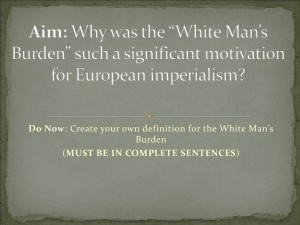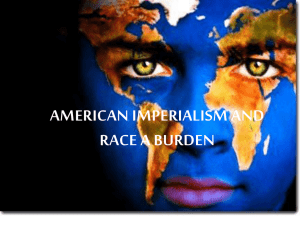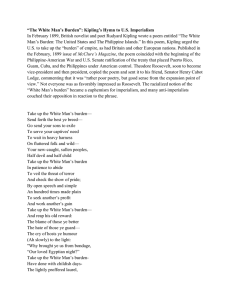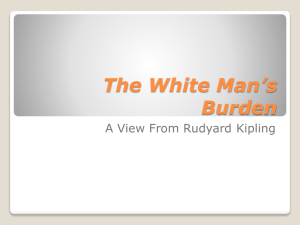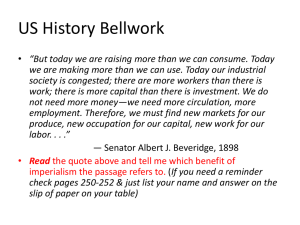Imperialism ARS - Teaching American History in SW Washington
advertisement
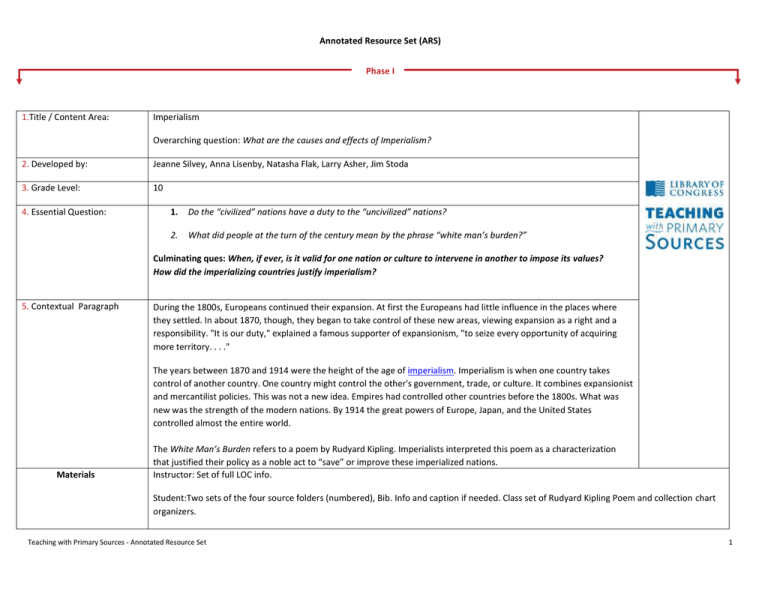
Annotated Resource Set (ARS) Phase I 1.Title / Content Area: Imperialism Overarching question: What are the causes and effects of Imperialism? 2. Developed by: Jeanne Silvey, Anna Lisenby, Natasha Flak, Larry Asher, Jim Stoda 3. Grade Level: 10 4. Essential Question: 1. Do the “civilized” nations have a duty to the “uncivilized” nations? 2. What did people at the turn of the century mean by the phrase “white man’s burden?” Culminating ques: When, if ever, is it valid for one nation or culture to intervene in another to impose its values? How did the imperializing countries justify imperialism? 5. Contextual Paragraph During the 1800s, Europeans continued their expansion. At first the Europeans had little influence in the places where they settled. In about 1870, though, they began to take control of these new areas, viewing expansion as a right and a responsibility. "It is our duty," explained a famous supporter of expansionism, "to seize every opportunity of acquiring more territory. . . ." The years between 1870 and 1914 were the height of the age of imperialism. Imperialism is when one country takes control of another country. One country might control the other's government, trade, or culture. It combines expansionist and mercantilist policies. This was not a new idea. Empires had controlled other countries before the 1800s. What was new was the strength of the modern nations. By 1914 the great powers of Europe, Japan, and the United States controlled almost the entire world. Materials The White Man’s Burden refers to a poem by Rudyard Kipling. Imperialists interpreted this poem as a characterization that justified their policy as a noble act to “save” or improve these imperialized nations. Instructor: Set of full LOC info. Student:Two sets of the four source folders (numbered), Bib. Info and caption if needed. Class set of Rudyard Kipling Poem and collection chart organizers. Teaching with Primary Sources - Annotated Resource Set 1 Procedures: Day before: model Sleeping Sickness on separate mini chart Lesson Day: 1. Bellwork: individual reading of Kipling’s White Man’s Burden. Fill in row one of collection chart. Discuss with a partner. 6. Resource Set (Model day before) The Sleeping Sickness Title: The sleeping sickness / Gordon Ross. Creator(s): Ross, Gordon, 1873-1946, artist Date Created/Published: N.Y. : Published by Keppler & Schwarzmann, Puck Building, 1911 October 25. Medium: 1 photomechanical print : offset, color. Summary: Illustration shows a large African man sitting, leaning against a tree, asleep; several European countries are staking claims to portions of Africa, planting flags labeled "England, Portugal, Belgium, Turkey, Italy, Germany, Spain, [and] France" all around the sleeping man. Reproduction Number: LC-DIG-ppmsca-27783 (digital file from original print) Rights Advisory: No known restrictions on publication. Call Number: Illus. in AP101.P7 1911 c-P&P(Case X) Repository: Library of Congress Prints and Photographs Division Washington, D.C. 20540 USA http://hdl.loc.gov/loc.pnp/pp.print Notes: o Title from item. o Caption: Cutting a continent out from under him. o Illus. in: Puck, v. 70, no. 1808 (1911 October 25), centerfold. o Copyright 1911 by Keppler & Schwarzmann. http://www.loc.gov/pictures/item/2011649074/ 1. Real "White Man's Burden" [poem] [from newspaper]SOURCE Cleveland Gazette 16, no. 37 (04/15/1899): 02CREATOR Crosby,Ernest,H.SUBJECTS Poetry Afro-Americans--Social conditions--To 1964 Real White Man’s Burden Creator Ernest Howard Crosby Context Expansion into the Philippines created antiimperialists who attacked American imperialism. Audience poetry Purpose MEDIUM NewspaperCALL NUMBER Newspaper Roll#4432REPOSITORY Ohio Historical Center Archives Library The general public and readers of his To parody Rudyard Kipling's The White Man's Burden by attacking American imperialism. Historical Significance Rudyard Kipling's poem "The White Man's Burden" argued that imperialism spread the benefits of civilization. Ernest Crosby's poem, "The Real White Man's Burden," parodied Kipling's, and showed his anti-imperialist abhorrence of war and sympathy for the Filipinos. The anti-imperialists were unable to stop the annexation of the Philippines, and their efforts went counter to the expansionist nationalism of those in power. Bellwork: indiv. Copies at each table http://memory.loc.gov/cgibin/query/h?ammem/aaeo:@field(DOCID+@band(o19095)) Teaching with Primary Sources - Annotated Resource Set 2 2. 3. The White Man's Burden, 1899 This famous poem, written by Britain's imperial poet, was a response to the American take over of the Phillipines after the Spanish-American War. Modern History Sourcebook: Rudyard Kipling Creator Rudyard Kipling Context Philippine-American War and the ratification of a treaty in which Cuba, Guam, the Philippines, and Puerto Rico came under U.S. control Audience Readers of McClure's Magazine Purpose To encourage the United States to take up the "burden" of empire Historical Significance In 1899, British poet Rudyard Kipling enjoined the United States to take up the "burden" of empire in his poem "The White Man's Burden: The United States and The Philippine Islands." Senator Henry Cabot Lodge noted that it was "rather poor poetry, but good sense from the expansion point of view." For some, the idea of the "White Man's Burden" became a justification for American imperialism. An alternative reading of the poem cautions the United States on the heavy toll of imperialism. Teaching with Primary Sources - Annotated Resource Set Willing to Compromise Title: Willing to compromise / Frank A. Nankivell. Creator(s): Nankivell, Frank A. (Frank Arthur), 1869-1959, artist Date Created/Published: N.Y. : J. Ottmann Lith. Co., Puck Bldg., 1901 January 23. Medium: 1 print : chromolithograph. Summary: Illustration shows a native king sitting on a throne, speaking with his advisors about the presence of a missionary on the coast. Reproduction Number: LC-DIG-ppmsca-25492 (digital file from original print) Rights Advisory: No known restrictions on publication. Call Number: Illus. in AP101.P7 1901 c-P&P(Case X) Repository: Library of Congress Prints and Photographs Division Washington, D.C. 20540 USA http://hdl.loc.gov/loc.pnp/pp.print Notes: o o o o Title from item. Caption: "Your Majesty," said the right-hand man of the native king, "there is a missionary working his way along the coast." "Well, we don't want to have any trouble," said the king. "Ask him if his people won't be satisfied with a coaling station." Illus. in: Puck, v. 48, no. 1246 (1901 January 23), cover. Copyright 1901 by Keppler & Schwarzmann. 3 Caption: "Your Majesty," said the right-hand man of the native king, "there is a missionary working his way along the coast." "Well, we don't want to have any trouble," said the king. "Ask him if his people http://yesteryearsnews.wordpress.com/2011/01/07/the-whitemans-burden/ won't be satisfied with a coaling station." http://www.loc.gov/pictures/item/2010651366/ http://www.fordham.edu/halsall/mod/kipling.asp 4. Civilization THE FILIPINO’S FIRST BATH Grant Hamilton Judge, New York, June 10, 1899 Here President William McKinley scrubs a Filipino savage with a brush labeled “Education” in the cleansing waters of “Civilization”. A freshly scrubbed Cuba and Porto Rico in the background are donning new clothes decorated with the U.S. stars and stripes. Teaching with Primary Sources - Annotated Resource Set 5. Pear’s Soap Title: The first step toward lightening the White man's burden in through teacing the virtues of cleanliness Date Created/Published: 1899. Medium: 1 photomechanical print : halftone. Summary: Advertisement for Pears' Soap, illustrated with a general washing his hands. Reproduction Number: LC-USZ62-86352 (b&w film copy neg.) Rights Advisory: Rights status not evaluated. For general information see "Copyright and Other Restrictions..." (http://lcweb.loc.gov/rr/print/195_copr.html). Call Number: Illus. in AP2.C8 c-GenColl Repository: Library of Congress Prints and Photographs Division Washington, D.C. 20540 USA Notes: o Halftone repro. of drawing. o Illus. in: Cosmopolitan (Advertising Section), v. 27, May-Oct. 1899. o No ref. copy. o This record contains unverified data from caption card. o Caption card tracings: Colonialism; The White Man's Burden; Adv. Soap; Hygiene. 4 Model image http://www.presidio.gov/NR/rdonlyres/3AD099E74401-420B-A6D1-A3E004012999/0/pt_wd_gallery7.pdf http://www.loc.gov/pictures/item/2002715038/ Phase II Foundations Annotations 7. Curriculum Standards History 4.3.1 Historical Interpretation Analyzes and interprets materials from a variety of perspectives in world history National Common Core: Key Ideas and Details 2: Determine the central ideas or information of a primary or secondary source; provide an accurate summary of how key events or ideas develop over the course of the text. Inegration of Knowledge and Ideas 9: Compare and contrast treatments of the same topic in several primary and secondary sources. 9. Content & Thinking Objectives Teaching with Primary Sources - Annotated Resource Set 5 Other Resources 12. Web Resources 13. Secondary Sources 14. Print and Other Media Resources Teaching with Primary Sources - Annotated Resource Set 6 Teaching with Primary Sources - Annotated Resource Set 7
